Jennifer Hallock's Blog: Sugar Sun Series Extras, page 16
June 23, 2017
More Sugar Sun teasers
It’s a hot summer! The teasers have been so popular—and so much fun to make—that I have a few more for you from the rest of the series. Enjoy!

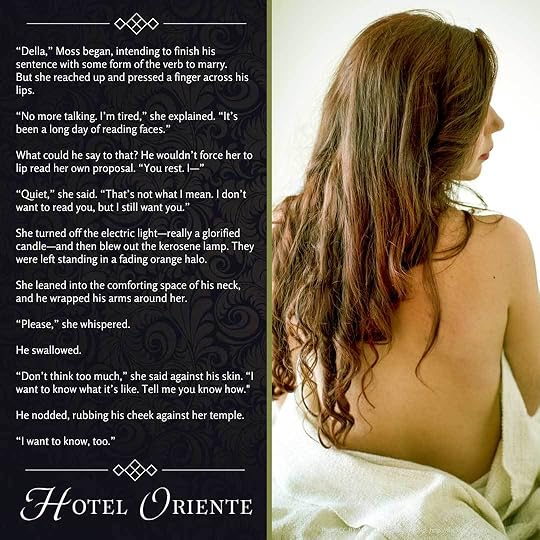
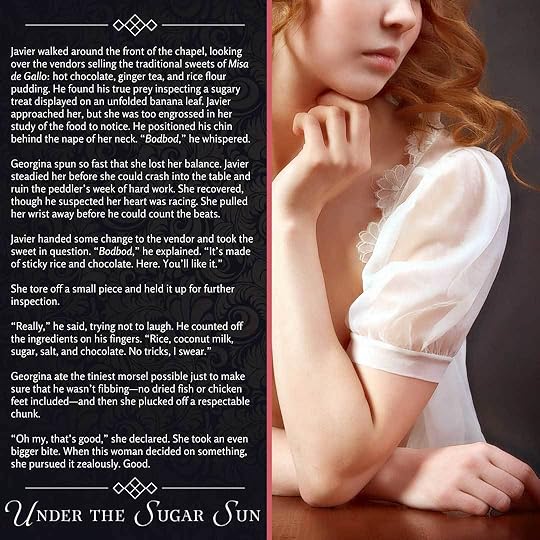
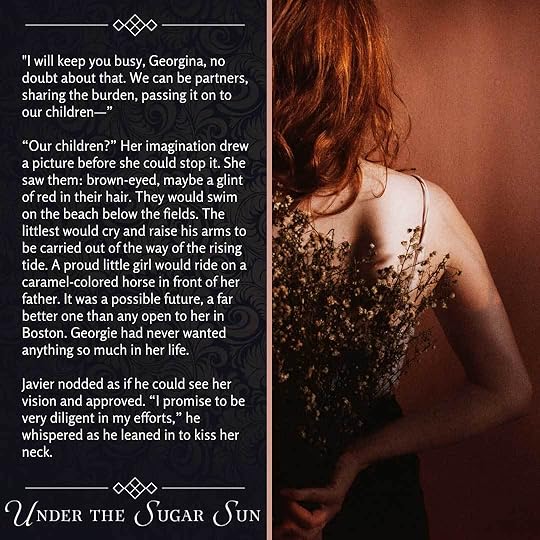
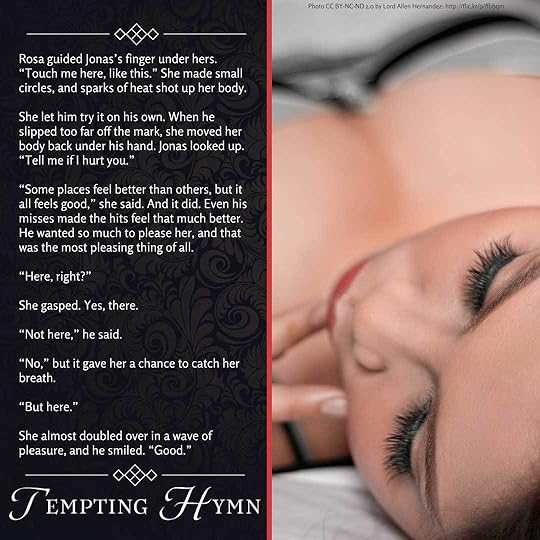

I will continue to create more for the #TeaserTues (#TeaserTuesday) and #ThursdayBookTease hashtags on Twitter, and I will post everything I make on both my instagram and Pinterest pages.
Note on all images used: All are either CC 2.0 licensed photos (which I may use with attribution, so check the fine print on the photo) or are released free of copyright (CC 0.0) and found at Pixabay, Pexels, or Unsplash.
June 19, 2017
Subscribe to the Sugar Sun series mailing list
Yes, I want to know when Jennifer Hallock publishes something new in her Sugar Sun series. I understand that she will guard my privacy, never give away my email, and not spam my inbox. She’s cool like that.
Email Address
Email Format
html
text
June 15, 2017
Sugar Moon teasers for the impatient
My writing process involves about ten set of revisions, and I am hopefully doing the last set now. Then it’s full-on editing time, and inevitably I have to rewrite something. My best guess for the arrival of Sugar Moon, book 4 in the Sugar Sun series, is—at the earliest—September 2017. (It will probably not be then. Sorry.)
But I’m having a blast writing (and rewriting) it, mostly because Allegra Alazas is such an ornery spitfire. People always look for pieces of the author in their characters, but I have to say that Allegra is totally her own woman. I wish I were as confident and blunt as she is. Maybe she’s aspirational to me. I don’t know.
Allegra (or “Allie,” as Ben calls her) is certainly what our troubled hero needs, both inside and outside the bedroom. By the way, this book will be sexy. The teasers below are pretty sexy. Just a warning. Or is that an inducement? You choose.
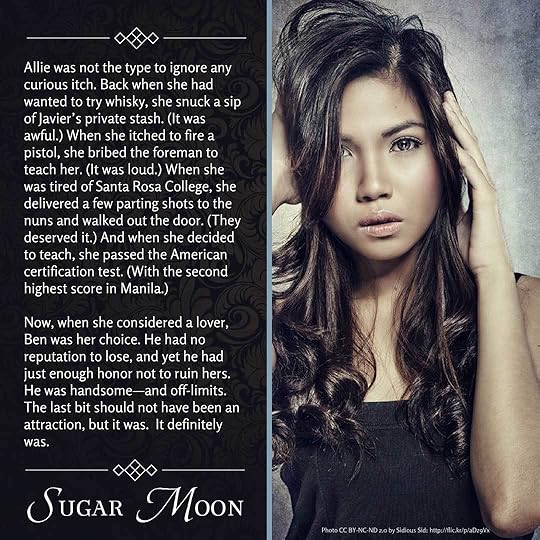



None of the text is set in stone, of course, because my editor hasn’t gotten to it yet. (It will be better and shorter when he is done.) But these are meant to whet your appetite, not satisfy it. I will continue to create more for the #TeaserTues and #ThursdayBookTease hashtags on Twitter, and I will post everything I make on both my instagram and Pinterest pages. So follow me at one of those places to keep up with all the latest from Ben and Allie. I also have a few favorite memories from the other books in the series, too. Enjoy!
Note on all images used: All are either CC 2.0 licensed photos (which I may use with attribution, so check the fine print on the photo) or are released free of copyright (CC 0.0) and found at Pixabay.
June 9, 2017
Sugar Sun series glossary term #31: banca (bangka) (but really this is the post on language)
What is a bangka? It depends on whom you ask.
Javier was not thrilled to be out on the water at such a late hour, even if the moon was bright and the rowers competent. Had this been a pleasure tour, the hacendero would have had no complaint, but tonight he wanted to get on with it or go home. As if they could read Javier’s mind, the rowers abruptly beached the banca, hopped out onto shore, and dragged the vessels away from the water line.
As you can probably guess from the context, banca or bangka means boat—specifically a double-outrigger canoe. If you have visited anywhere outside Manila, you have probably taken a bangka. When I first drafted Sugar Moon, Ben and Allie did a fair amount of bangka travel in Samar.
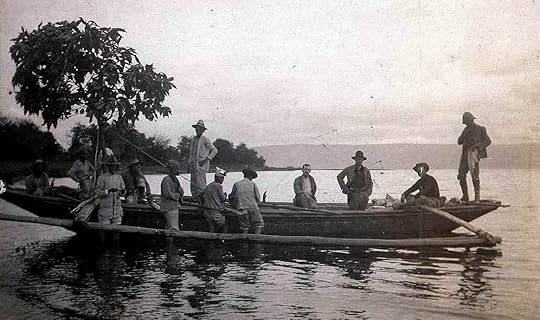 A colonial photograph of a banca in the crater lake of the Taal volcano, accessed at the University of Michigan Philippine Photographs Digital Archive.
A colonial photograph of a banca in the crater lake of the Taal volcano, accessed at the University of Michigan Philippine Photographs Digital Archive.But here’s the problem: bangka may mean outrigger canoe in Tagalog and Cebuano, but I found out that it means cockroach in the Waray language of Samar, Biliran, and parts of Leyte. While strange stuff happens in Sugar Moon, riding a cockroach through the surf is a whole new level. So I took the word out and used boring old English.
The Implication
This brings up an important point about the Philippines: it the tenth most linguistically diverse country in the world. There are eight language groups, 19 local languages that can be taught in early childhood education (from kindergarten to 3rd grade), and now 200 total languages identified. Such linguistic abundance makes geographic sense. The Philippines is an archipelago nation of 7,641 islands, and it is so spread out that it stretches almost from Seattle to Los Angeles. No wonder one language could not dominate. But this doesn’t make things easy.
 On left, an area comparison map of the Philippines as created by the Central Intelligence Agency; on right, a linguistic map of the Philippines by GeoCurrents.
On left, an area comparison map of the Philippines as created by the Central Intelligence Agency; on right, a linguistic map of the Philippines by GeoCurrents.As you may remember from previous posts, the Americans turned this rich multilingual heritage into a justification for a monolingual (English) education system. English is still one of the two official languages of the country, along with Filipino. (Filipino is the “most prestigious variety” of the Tagalog language of Metro Manila, according to the chair of the Komisyon sa Wikang Filipino, or the Commission on the Filipino Language.)
For the purposes of my series, Filipino (or Tagalog) had not yet been designated official (1937), which means that regional languages, such as those in the Visayas (like Cebuano and Waray) would have been even stronger at the beginning of the twentieth century. I have to thank Liana Smith Bautista (and her mom) for being my newest go-to research sources on Cebuano, though all errors in my books are my own. I also am deeply indebted to the creator of the amazing Binisaya online dictionary and reference guide.
 From the article “Debunking PH Language Myths” in the Inquirer newspaper.
From the article “Debunking PH Language Myths” in the Inquirer newspaper.American readers, have I utterly confused you? The number of indigenous languages is daunting—and I have not even mentioned the foreign tongues spoken in some families, like Hokkien (from China). Is it any surprise that most Filipinos grow up bilingual, at the very least? As Javier said to Georgina when they first argued about her English textbooks: “I grew up bilingual, learned three more languages in school, and another while traveling. It’s only Americans who can’t seem to manage more than one.” (And with the direction of funding for foreign language education in US public schools, we will not be getting much better.)
Allegra is a polyglot, too, by the way:
“To be honest,” Ben said, “it’s a little eerie how American you sound, Allie. From what the folks here tell me, you also speak Spanish like an Iberian. And Cebuano, and Tagalog, and Latin…”
She used her other hand to wave away the compliments. “I was raised speaking Spanish in the house and Cebuano everywhere else, and I had to learn Tagalog in Manila. No one but a priest speaks Latin, but I learned how to read it in school—”
“You’re missing my point. You’re a linguist, a natural.”
She blushed even more furiously than when he had first taken her hand. “Thank you.”
“Don’t thank me yet. I’m telling you why you scare those American phonies at the club. Do you really think they’ll award you a scholarship for being smarter than they are?”
— Sugar Moon (upcoming)
Ben’s respect for Allegra’s intelligence has been one of the most fun things about writing this couple. He is not a scholar and doesn’t pretend to be, but he is not intimidated by her skills, either. In fact, as we’ll see, he needs them.
So we’ve gotten a little bit away from the bangka in this glossary “definition”—sorry—but you probably just needed a picture for that. (If you want more nautical know-how, read about this group trying to help local fishermen design bangkas out of fiberglass—a light, durable, super-typhoon-proof alternative to wood.) Otherwise, I hope that you, like me, have learned a larger lesson about language through the study of this one little word.
 Maybe we all need a vacation to ponder these languages a bit more. Photo at Pixabay. Featured photo at top of post also from Pixabay.
Maybe we all need a vacation to ponder these languages a bit more. Photo at Pixabay. Featured photo at top of post also from Pixabay.
June 7, 2017
How to Blue Apron: Jen’s Tips from Sabbatical
Note: I received no compensation from Blue Apron for this post. (I mean, if they offered, I might take it. But they didn’t.)
One of the biggest drawbacks of sabbatical was losing access to my school’s wonderful dining hall. Would I ever eat a vegetable again? I certainly did not know how to cook any.
Enter Blue Apron. My friends at work laugh because they don’t think this is really “learning how to cook.” That’s unfair. As you can see, these are not ready-made kits. You are sent raw grocery ingredients, along with instructions on how to prepare them. That’s cooking! Blue Apron does have its peccadillos, though. Here’s how I’ve learned to best “Blue Apron” your kitchen:

Buy a big thing of quality olive oil and keep it next to you at all times. Don’t worry too much about measuring oil for your pan, like the instructions say. Learn to eyeball it.
Keep kosher salt in a bowl for easy seasoning—you’ll do it a lot. I also recommend a good pepper grinder.
The box of food comes once a week, but don’t worry about sorting through it right away. Just throw it all into one of the bottom drawers of your fridge, and keep it separate. (If you use Blue Apron, you will be buying less food at the store. You’ll find the room.)
Use your dishwasher to clean all those prep bowls and plates, especially if it has a quick cycle. Treat yourself.

Blue Apron’s instructions show every ingredient in its own cute little bowl. Well, dishwasher or no, that’s a lot of waste. Read down the instructions and find out what’s going to be thrown into the pot together, and combine them now. You can see the comparison between Blue Apron’s prep bowls and mine for the same dish (above). Because the ginger and rhubarb were going to be cooked together, I let them start together. Same with the celery, garlic, and scallion bottoms. Why not?

You will be peeling a lot of vegetables. (Mr. Hallock and I are not vegetarians, but Blue Apron does excel at vegetable-rich dishes.) Get comfortable with a selection of peelers and knives to take the skin off everything from radishes to large squash.
Deseeding lemons? No, thank you. Look at the instructions, see how the juice will be used, pre-squeeze it, and fish out the seeds.
Those are just a few easy tips for making cooking manageable with Blue Apron. I’ll be back in the dining hall soon, but I will be keeping a lot of the recipe cards for my own “sabbatical cookbook.” And this from a woman who had to be taught how to boil water in college. You can teach a dog new tricks!
June 1, 2017
Sugar Sun series glossary term #33: water cure
I spend a lot of time writing about the good stuff, like sex on traditional Philippine furniture. (For example, here and here.) But my blog is not all fun and games. I have set my novels in the Philippine-American War, and that was a horrible war. I have posted before on how the war began, how it was conducted, and a little bit about battles and operations—but I have avoided this particular post for a long time. This is the post on the water cure.
If you’re not feeling like anything disturbing, heavy, or possibly enraging, do go check out those other posts about sexy times on antique furniture. Come back to this another time.
Warning: If you do choose to stay, please note that this post discusses a practice motivated by racism. A few of the historic sources include racist language or judgments.
 The 35th US Volunteer Infantry Regiment in what is thought to be a staged photo of the water cure. The fact that this group of men did stage it reveals a lot about how normalized the practice was to them.
The 35th US Volunteer Infantry Regiment in what is thought to be a staged photo of the water cure. The fact that this group of men did stage it reveals a lot about how normalized the practice was to them.The water cure is a little different than modern-day waterboarding. In waterboarding, water is poured over a cloth covering the face to simulate the sensation of drowning. That may seem like it’s some sort of fake out, but it does cause real injuries. The water cure, though, is even more physical. In this practice, they laid a prisoner on his back, stood another man on each hand and foot, and forced a hollow tube into the victim’s throat. Through the tube they poured an entire pail of saltwater, dished up with a little sand to inflict a more severe punishment. When the prisoner did not give up, they poured in another pailful. Once the unlucky victim’s belly was “distended to the point of bursting,” a soldier would “tap” it with the butt of his gun. If the water did not spout high enough, they would jump up and down on his stomach. In the words of A. F. Miller of the 32nd Volunteer Infantry Regiment: “They swell[ed] up like toads. I’ll tell you it [was] a terrible torture.”
According to historian Darius Rejali, “Even a small amount of water in the glottis causes violent coughing, initiating a fight-or-flight response…triggering desperate efforts to break free. The supply of oxygen…is exhausted within seconds. While this is sometimes called ‘an illusion of drowning,’ the reality is that death will follow if the procedure is not stopped in time.” And it did.
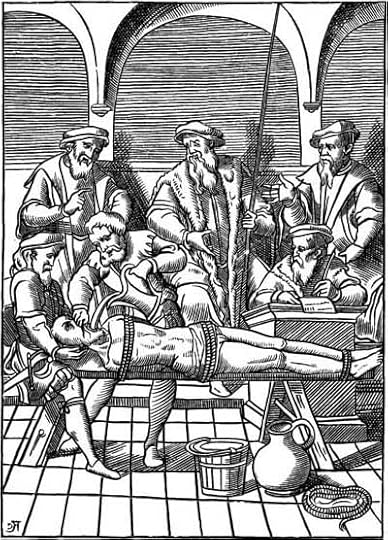 Facsimile of a Woodcut in J. Damhoudère’s Praxis Rerum Criminalium, Antwerp, 1556.
Facsimile of a Woodcut in J. Damhoudère’s Praxis Rerum Criminalium, Antwerp, 1556.This cruel technique was first introduced in the Spanish Inquisition and then spread throughout medieval Europe. The Spanish brought it to the Philippines, trained local scouts in the practice, and then those scouts taught the American soldiers. Some soldiers were more eager than others to use it. Major Edwin Glenn and “Glenn’s Brigade” were infamous for water curing thirteen priests of Samar—half of the clergy on the island—and they even killed one of the priests in the process. This was a part of the “howling wilderness” period.
When the American public found out about what Glenn had been up to in the islands, he was court-martialed. Actually, Glenn was brought to court three times. The first time he was found guilty of uncivilized conduct in war, despite his claims that the water cure could be a remedy for dengue fever. (Yes, he really did try that excuse. He even called witnesses to testify to this. It’s in the 1902 archives of the Manila Times.) He was given a one-month suspension and fined fifty dollars. (In comparison, the man he water cured that time, the mayor of Igbaras in Iloilo, was sentenced to ten years hard labor for what he was confessed under duress.) Glenn was court-martialed a second time for killing seven prisoners of war, though he was acquitted. Finally, he was sued in civil court for $15,000 (over $420,000 in 2016 dollars) by a former revolutionary named Calda. I have never found out how this last case ended, but I do appreciate the hutzpah that encouraged it. Since Glenn retired as a brigadier general from the Army, I can assume that nothing stuck.
 One US veteran wrote a series of fiction novels about the war, and he included an image of the water cure in the preface illustrations.
One US veteran wrote a series of fiction novels about the war, and he included an image of the water cure in the preface illustrations.Stories like the ones about Glenn’s Brigade were said to have “covered with a foul blot the flag which we all love and honor” by Senator Hoar (R) of Massachusetts. This led to an official inquiry in the Senate by the Committee on the Philippines. The discussion was fractious. Henry Cabot Lodge, another Republican senator from Massachusetts, chaired the committee—not because he wanted to uncover atrocities, but because he wanted to steer the committee away from doing any such thing. (Yes, two senators from the same state and the same party were sworn enemies on this issue.)
Lodge in particular did not want to criticize anything that soldiers did in the name of empire. He said that the water cure had:
…grown out of the conditions of warfare, of the war that was waged by the Filipinos themselves, a semicivilized people, with all the tendencies and characteristics of Asiatics, with the Asiatic indifference to life, with the Asiatic treachery and the Asiatic cruelty, all tinctured and increased by three hundred years of subjection to Spain.
Way to pass the buck, dude. (I’d like to remind readers that the water cure originated in Europe, not Asia.)
 The 22 May 1902 cover of Life magazine captures the national (and international) discussion about the water cure. The British veterans in the background are saying: “Those pious Yankees can’t throw stones at us any more.”
The 22 May 1902 cover of Life magazine captures the national (and international) discussion about the water cure. The British veterans in the background are saying: “Those pious Yankees can’t throw stones at us any more.”Despite Senator Lodge’s and Senator’s Beveridge’s (R-IN) staunch support of “military necessity,” soldiers did testify to atrocities they witnessed in the Philippines. Even Lt. General Nelson A. Miles told the Secretary of War that the conflict had been fought with “marked severity.” The evidence, and Miles’s remarks, were printed in the newspapers across the United States.
Novelist and prominent anti-imperialist Mark Twain wrote about the hypocrisy of Americans fighting a war to “civilize” another country and then succumbing to the very barbarism they sought to expunge. His essay “To the Person Sitting in Darkness” is one of his best and most biting pieces of satire:
The Person Sitting in Darkness is almost sure to say: “There is something curious about this — curious and unaccountable. There must be two Americas: one that sets the captive free, and one that takes a once-captive’s new freedom away from him, and picks a quarrel with him with nothing to found it on; then kills him to get his land.” …And as for a flag for the Philippine Province, it is easily managed. We can have a special one — our States do it: we can have just our usual flag, with the white stripes painted black and the stars replaced by the skull and cross-bones.
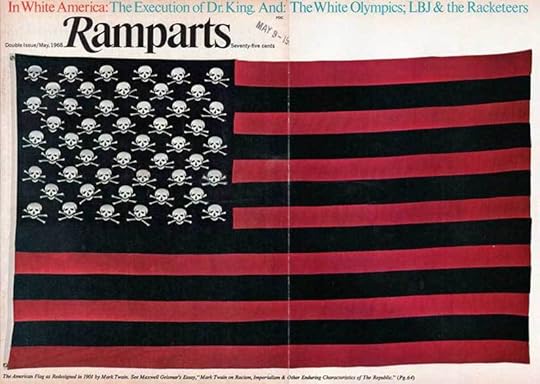 The Twain version of Old Glory, as republished in 1968 on the cover of Ramparts magazine.
The Twain version of Old Glory, as republished in 1968 on the cover of Ramparts magazine.In the midst of the 1902 crisis, President Theodore Roosevelt tried to limit the damage to blaming a few weak men:
The temptation to retaliate for the fearful cruelties of a savage foe is very great, and now and then it has been yielded to. There have been a few, and only a few, such instances in the Philippines, and punishment has been meted out with unflinching justice to the offenders.
But was this truly just a few bad apples? Certainly, many of the soldiers knew of the practice. They even sang songs to it.
 A soldier’s song as published in Life magazine 8 May 1902. Some sources suspect that the lyrics were originally written as satire, but others report it being sung widely by soldiers in all seriousness.
A soldier’s song as published in Life magazine 8 May 1902. Some sources suspect that the lyrics were originally written as satire, but others report it being sung widely by soldiers in all seriousness.The commanders in the field knew better than to underestimate the problem. In 1903, an expedition in Surigao declared:
…let there be no water curing or severity that is not plainly authorized without straining interpretations of [the] law of war… .Anyone who disgraces our uniform by engaging in such barbarous practices will be punished on the spot… .Success will not be marred by any well founded complaints of undue severity and flagrant misconduct.
What does this prove? That seventy years before Vietnam and one hundred years before Iraq, there was a national conversation about how America should exercise its authority abroad. Unfortunately, though, nothing was concluded. The controversy was quelled by a conveniently timed declaration of “peace” in the islands on July 4, 1902. (It was not peace, though: fighting would continue until 1913, including other, bigger atrocities, like the hundreds of civilian dead at Bud Dajo.)
When the military handed power over to a civil government under Governor William Howard Taft, Americans at home believed their problems were solved. However, because America did not finish the conversation, the public was forced to have it all over again in 1969 (when the My Lai massacre story broke) and in 2004 (when the Abu Ghraib torture and prisoner abuse scandal broke). Does the end always justify the means? What if the means makes the end goal—peace—impossible? Unfortunately, Americans may be tiring of these questions before they can come to a consensus about the answers.
(Note: Featured image is a cartoon by William Carson, which was printed in the Saturday Globe (Utica, New York) on 8 April 1899. It shows Uncle Sam sinking into the quagmire of the Philippine-American War as Filipino leader Emilio Aguinaldo resists his American “rescue.” The caption says, “A bigger job than he thought for.” Uncle Sam says: “Behave, you fool! Darn me, if I ain’t most sorry I undertook to rescue you.”)
May 26, 2017
Non-Romance Influences: Colonial Literature
I’ve talked a lot on social media about my romance novel influences (e.g. Laura Kinsale, Joanna Bourne, and others), but I’ve not mentioned authors and books that have meant just as much to me as a writer, especially pre-romance days. So I’m starting an occasional series on all the works of fiction, science fiction, children’s fiction, and adult nonfiction that have permanently taken up real estate in my brain.

My literature exposure in public high school was hit or miss, depending on the teacher I had. I tried to make up for this in college, even though I had passed out of my English requirements and took only international relations and history courses. My first year I took a required class called “Empire and Independence in the Modern World,” with a specific focus on Africa, where I was assigned Chinua Achebe’s Things Fall Apart. That was a revelation. I also studied a lot of Southeast Asian history and politics, and that professor must have had me read The Quiet American by Graham Greene three times in three separate classes. It was not a hardship. I loved it from the start. I think I also picked up Burmese Days by George Orwell on this professor’s recommendation. Finally, my then-boyfriend, now-husband, suggested James Clavell’s Tai-Pan as “fun” and “light”—which, in comparison to most of the heavy nonfiction we had to read, it was. Now, as I look back upon this college reading, I realize two things:
First, far too many of these books were written by white men, even when the subject was the injustice of colonialism. I did not question this fact too much as a student, but then again most of my professors were white men. I have read more widely since, but this post is really about the books from my youth.
Second, flawed or not, these novels left a big impression. They shaped how I approach a fictional treatment of the American colonial Philippines.
Things Fall Apart by Chinua Achebe

Things Fall Apart is a story of a Nigerian village before and after the arrival of British missionaries. The first half of the book gives no hint of what is coming: it is the story of an ambitious man in the village and his downfall. It is a story that could be told anywhere, and yet it is distinctly Nigerian. This is Achebe’s point. He portrays Igbo society as complex and flawed at times—like every other society on the globe. But, with the arrival of Protestant missionaries and British officials, everything falls apart. The beliefs, laws, and customs of the village are turned on their head, and this is not good. Interestingly, not all of Achebe’s missionaries are bad people. The first white man to arrive in the village thinks he is doing good work. He listens to the Igbo people’s problems and welcomes all who seek his help. Ironically, it is his compassion that accelerates the rate of conversion and hastens the collapse of the traditional village structure. This is a beautiful, nuanced story of the consequences—some unintended—of European rule in Africa. It explains why many parts of Africa have had such a hard time recovering.
 A photo of Achebe around the time of the publication of Things Fall Apart.
A photo of Achebe around the time of the publication of Things Fall Apart.Achebe grew up with a foot in both worlds: he was the child of converted Protestants, born in the city and educated in British-style schools; but his parents always kept ties with their traditional religion, and they moved their children back to their ancestral village at a young age.
Achebe was well-versed in the canon of British literature, but he was not afraid to criticize it. He especially criticized Joseph Conrad’s Heart of Darkness for celebrating the dehumanization of the African people:
It is clearly not part of Conrad’s purpose to confer language on the “rudimentary souls” of Africa. In place of speech they made “a violent babble of uncouth sounds.” They “exchanged short grunting phrases” even among themselves. But most of the time they were too busy with their frenzy.
I am not saying that Achebe wrote Things Fall Apart in contrast to Conrad’s Heart of Darkness. He wrote his novel based on his own experiences, twenty years before he gave that speech on Conrad. But the two books are a remarkable pairing. I prefer Achebe’s discerning view that portrays all characters—Nigerian or British—with very human strengths and weaknesses.
Takeaways: complex social networks, multiple perspectives, ambiguous characters, unintended consequences.
BURMESE DAYS BY GEORGE ORWELL

Orwell was born in Bengal and worked as a policeman in what is now Burma—both parts of the British crown colony of India at the time. According to the original dust jacket of Burmese Days, he resigned “because he disliked putting people in prison for the same things which he should have done in their circumstances.” Six years after he quit, he published a scathing indictment of colonial superciliousness in novel form. This is Burmese Days. Orwell’s treatment was so controversial at the time (1934) that one of his former colleagues claimed he had “rather let the side down” and his former principal threatened to horsewhip Orwell if he ever saw him again. Orwell claimed that most of the book was “simply reporting what I have seen.” (Source)
 This book could never be romance. It’s about racism, poverty, prostitution, spurned love, and suicide. No HEA at all. Not even close. And while there is sort of a hero, Flory, he’s pretty wishy-washy. And there is no true heroine—Flory’s love interest is the most infuriating, horrible snob. You want to throw her—and her friends and family—off the roof of the British club, where most of the novel takes place.
This book could never be romance. It’s about racism, poverty, prostitution, spurned love, and suicide. No HEA at all. Not even close. And while there is sort of a hero, Flory, he’s pretty wishy-washy. And there is no true heroine—Flory’s love interest is the most infuriating, horrible snob. You want to throw her—and her friends and family—off the roof of the British club, where most of the novel takes place.
The characters are not subtle, and the Burmese in the story are superficially drawn. (For all-around depth, read Achebe.) Orwell did not understand the Burmese as well as he understood—and was disgusted by—his fellow countrymen. His novel exposes the small-mindedness of white imperialists, and it does so in a visceral, immediate way. You will not like most of the characters in the book, but that is the point. Orwell didn’t, either. Clearly, he felt a lot of ambivalence while working in India: he wanted a paycheck, but hated the way he was getting it. He proved luckier than his “hero,” though, and quit instead of doing himself harm—which is good since Orwell had still to write 1984. (That will be covered in a later post, of course.) It is unbelievable to me that out of the original 2000 print copies of Burmese Days, over 900 had to be remaindered because the book was so badly panned by the critics. (Maybe that’s encouragement to us all.)
Takeaways: critical portrayal of the “white club” phenomenon in colonial societies, complex political points made through conversation.
The Quiet American by Graham Greene
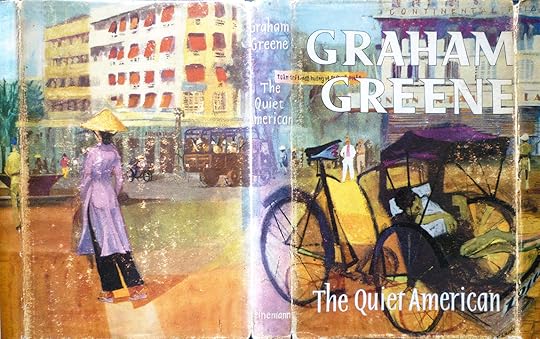 The special literary edition cover of Graham Greene’s The Quiet American, as painted by Peter Edwards, illustrator of Thomas the Tank Engine.
The special literary edition cover of Graham Greene’s The Quiet American, as painted by Peter Edwards, illustrator of Thomas the Tank Engine.Moving into neo-colonial fiction, the Quiet American is loosely based on a real spy: an American CIA officer named Edward Lansdale. Lansdale was the “advisor” who helped elect Philippine President Ramon Magsaysay in 1953, and together they pulled the teeth out of a communist insurrection in Luzon. After that success, Lansdale was sent to Indochina, just as the French empire was dying, with instructions to shore up South Vietnam’s President Ngo Dinh Diem against the growing communist movement. He was not as successful the second time around.
 A quote from The Quiet American that shows the layered, yet simple style of Graham Greene.
A quote from The Quiet American that shows the layered, yet simple style of Graham Greene.Greene’s version of this tale reimagines Lansdale as a seemingly naive foreign aid bureaucrat named Pyle. The story is told from the perspective of a jaded British reporter, Fowler, who notices that wherever our quiet American goes, trouble follows. And, of course, there is a woman, Phuong, that they compete over. But this is not a romance, either. It is a beautiful, profound, and yet hardboiled story. There’s action, too, with battle scenes based on real events. Most importantly, the book explains the American entrance into this war in the 1950s—and it predicts its disastrous end—but you hardly notice these lessons because you are too wrapped up in the humanity of the story. The Quiet American was made into a gorgeous movie, for which Michael Caine received an Academy Award Nomination.
Takeaways: using real people and events as inspiration for fiction, masterful weaving of political points into human drama, setting as character.

Tai-Pan by James Clavell

This story is about the creation of Hong Kong in the nineteenth century. It features British, American, and Chinese traders and blockade-runners who build a free market playground to make themselves rich. Clavell himself was a fan of Ayn Rand’s Objectivism, which will come as no surprise when you read the book. And this is not the only thing that makes Clavell’s fiction problematic. Tai-Pan actually romanticizes colonial acquisition at the same time that it claims to honor Asian culture. Nor am I sure that he had a lot of respect for women. Honestly, I cannot think of much that he and I would have agreed on. And this book isn’t literary, like the three works above. It’s not even my favorite of the author’s novels. (That’s King Rat, based upon Clavell’s own experiences as a Japanese prisoner of war in World War II.)
So what makes it special? Clavell is a heck of a storyteller. An epic storyteller, really, creating dynasties that span hundreds of years. This is solid genre fiction—and yet Clavell does not sacrifice content to bring you a pulpy, fast-paced novel. He especially does not back away from economic history. Yes, it’s a little laissez-faire for my tastes, but it’s still well-told. I loved the subtleties of his negotiation scenes, including a nuanced use of chopsticks that still makes me self-conscious about my lack of finesse. Finally, Clavell gives voice to mixed race characters, who are often the most sympathetic of the lot.
Takeaways: economic and historical content that is highly readable, excellent pacing, subtleties of interactions between characters, cross-cultural relationships and mixed race characters.
 Vista of Hong Kong from the Peak.
Vista of Hong Kong from the Peak.Edited to Add:
 From the 60th Anniversary production of the opera Noli Me Tangere at the Cultural Center of the Philippines. Yeah, Jose Rizal (on screen) was a historical hottie. I’ve got a thing. Not gonna lie.
From the 60th Anniversary production of the opera Noli Me Tangere at the Cultural Center of the Philippines. Yeah, Jose Rizal (on screen) was a historical hottie. I’ve got a thing. Not gonna lie.I did not include Jose Rizal’s Noli Me Tangere to this list only because I plan to do more with it and the role it played in fomenting the Philippine Revolution when I get closer to publishing Padre Andrés’s book, Sugar Communion. Until that time comes, let me say that the Noli is another seminal work of colonial literature. It was written by an author of color, but (like the others) penned in the language of the imperialists, in this case Spanish. Rizal deserves a post of his own because I cannot explain all the ways he fascinates me here.
Noli Me Tangere is about the unchecked power of the Spanish in a system based on race and class, and how this leads to a pretty depressing end for most of the Filipinos in the story. What I especially liked about this book was the voice given to otherwise minor characters, like the devoted mother of two young sacristans in the church. I also loved the social commentary delivered in ornate dinner and banquet scenes. Throughout, Rizal was making a political point about the cruelty and hypocrisy of Spanish friars. He did not seem to be espousing violent revolution, though, at least not in this book. But he did want equal treatment under the law. It shouldn’t have been a big ask.
Takeaways: depth of secondary characters, nuanced political discussions, setting as character.
May 18, 2017
The Business Workshops of #RT17
Last week, I told you a bit about the craft workshops and panels I attended at #RT17. This week, I’m all business. This is long, so you might want to digest it in chunks.

You can read a comprehensive recap of this workshop by Smashwords founder Mark Coker at author Cecilia Tan’s blog here, and most of it you already know: digital publishing has democratized publishing; romance has led the way in professional-quality independent publishing; and that there is a glut of high quality, low-priced books. The ability to inventory digital books for basically free means that everything stays in print and on the market forever. This increased supply has pushed down prices, especially for new authors.
Coker ended the presentation with a call for author mobilization against KDP Select, Amazon’s exclusivity program with subscription-based pricing. He portrayed KDP’s system as predatory pricing, a monopolistic practice that threatens to put Amazon’s competitors out of business. This threatens the newly-found independence and choice of independent authors. We have just been released from bondage to the Big Five, and now we’re in bondage to Amazon, according to Coker. While this may be true, he did not fully recognize the prisoner’s dilemma that Amazon presents to authors. If we all stood up together as one and refused to participate in KDP, we would all be punished equally by Amazon’s algorithm—meaning none of us would be punished. This might put KDP out of business. But without collective action, pulling out of KDP will only hurt the individual author who takes the stand. Your books will be buried in Amazon, and other authors will be thrilled to take your spot at the top of the bestseller lists. In this prisoner’s dilemma, no one chooses the collective good over their own self-interest. That’s human nature, and Amazon knows it.

This presentation was less ideological and more data-driven than the first. Some of the data followed the trends seen in his 2016 survey, but let me recap what I found particularly interesting. Note that all of this is based on averages, so your mileage may vary. The survey showed that among his authors:
Write as long as you need to. The top 70 bestselling romance authors at Smashwords average 92,000 words (excluding box sets) and 113,000 words (including box sets).
But keep the titles short. The top 100 bestsellers at Smashwords have 24.45 characters on average in the title, while the 900-1000 bestsellers have 30.11 characters on average. The last 100 surveyed (bestsellers 9,900-10,000) average 35.5 characters.
How much should you charge for your ebooks? Free books still get the most downloads, but among books for sale, the best range is still from $2.99-$4.99. The spot at $1.99 is a dead zone. It seems to be better for Smashwords authors to price at $0.99 or $2.99 than $1.99.
If you write a series—and, yes, they still dominate the romance market—you should give away the starter for free. 7 out of 10 of the bestselling series on Smashwords have a free starter. Interestingly, 4 of the 10 did not have any new book in the series published within the survey period (a year), which shows the persistence of series, even when complete or on pause.
Should you put your books up for preorder? Especially in the iBooks store, yes. They count your preorders as first day sales, unlike Amazon where they are counted on the day the purchase is made. Coker found that of the top 1000 bestselling authors, 61.7% released at least one book on preorder. There could be other factors at work, like the fact that the most professional and organized authors might be the one getting their act together for preorders. Maybe they have nicer covers, better writing, and better advance marketing, he suggested.
Should you do a box set? “Box sets are not the path to riches, but they can be a nice complement to your publishing strategy,” Coker said. Authors participating in at least one box set—whether alone or with other authors—are highly represented among bestselling authors. However, in my opinion, this may be more a function of catalog size than actual box set sales. Authors with more books in the backlist tend to have higher earnings and more followers, and these are the authors who have the material to create a box set. Moreover, the best selling box sets are $0.99, which is a pretty low value on that many words.

This workshop featured two executives of Written Word Media, the team behind FreeBooksy and Bargain Booksy. It was a little free-form, but here are the takeaways that I think may interest fellow authors:
Perceived value was a very interesting concept to me. Giving a book away for free without any hurdles not only loses you revenue, but it also lowers the “perceived value” of your book. But if you take an email address from a reader in order to get the book, that adds perceived value. Perceived value can also come from a reader pay to attend an event. Another trick is to keep the price on the back of the book the same as others in industry, and then put “special price” stickers on it. This way you can give special sales at specific events while still keeping the perceived value of your book high.
Covers are important, but they do not make the sale. They need to accurately represent the genre, general theme, and relative professionalism of the book—but NOT the whole plot! The point of a good cover is to get someone to read the blurb. The blurb sells the book.
In terms of ebook sales, the panel sees people making the most at the $2.99-$4.99 range, which agrees with Coker’s findings. (And, by the way, Coker joined the panel informally.) Bargain Booksy thinks that middle-range prices ($4.99) with flash sales (“for a limited time only”) is a good strategy.
Not surprisingly, it is easier to bring prices down than up. If you need to increase prices, do so incrementally.
As you might expect, pricing will expand and contract based on the number of books being released. This is supply and demand. The last two years have seen a lot of people fall out of the market, which is why we see prices going up a bit.
 You do NOT want your cover to describe the entire plot of your book. Case in point: this Shutterstock image has so many elements that are perfect for the story of Sugar Moon, including two reasonably good models, a jungle setting, and a big frickin’ moon. But if you would buy my book based on this photo, then I also have a bridge in Brooklyn to sell you.
You do NOT want your cover to describe the entire plot of your book. Case in point: this Shutterstock image has so many elements that are perfect for the story of Sugar Moon, including two reasonably good models, a jungle setting, and a big frickin’ moon. But if you would buy my book based on this photo, then I also have a bridge in Brooklyn to sell you.

To be honest, this workshop turned into an infomercial of why we authors needed a traditional publisher, especially Sourcebooks. Even though I am fond of Sourcebooks because they published a few of Laura Kinsale’s books, I was still annoyed by their attitude. Nevertheless, there were a few interesting bits of data:
There are impulse buyers out there! In a Neilsen study of romance book buyers, 23% planned to buy one specific book at specific time; 23% planned to buy the one specific book, but not at a specific time; 26% planned to buy a book at a specific time, but not any particular book; and 30% didn’t plan to buy anything at all, making it a total impulse purchase.
How do readers first find you? Browsing the store accounts for 15% of first discovery. Reader recommendations account for 15%, but it needs to be recommended three times. Your author marketing accounts for 14%, but people need to see your materials at least twice. Finally, print and other analog (non-internet based) publicity counts for 13%, but it needs reinforcement 2.5 times. Bottom line: your marketing has an impact, but it’s best when reinforced by another source.
What do readers want to hear in your marketing? 31% of book purchases are based on book message. How do they like the sound of your story? 26% buy because they like your other books or the rest of your series. 15% is based upon reader recommendations. Only 8% of purchasing decisions are based upon special pricing alone, so don’t just drop your prices without a plan. Make sure you have a good book message, too!
Sourcebooks’ data also suggests that “freegans” will not convert to “paygans.” Just because people download your book for free doesn’t mean they will purchase more. This seems to contradict Coker’s data. (See above.)

Much of what I learned in this workshop is hard to describe because it was based on the attendees pitching to ReShonda. She was brutally honest in her advice, but it was totally warranted. ReShonda was definitely the best teacher at the conference. I’m a little bit in love with her. Here are a few of her points:
Twitter has become a requirement in many newsrooms today. Follow your local reporters and know what they cover. This helps you find the right person for your story.
When you call or contact a newspaper or television station, there is no “my book this” or “my book that.” Have your assistant call the newsroom, even if your “assistant” is you (under a different name). First talk about a critical issue the reporter should be aware of, and then reveal that a local expert (ahem, that’s you) wrote a book about this very problem. Give your pitch as a story, not a summary.
Email a pitch for a weekend feature first thing Thursday morning. If you try to do it late Wednesday, it will get buried in the pitches that come after you. And if you wait too long, they will be working on other things before yours. And why Thursday? Because it gives them time to consider your book for their weekend story planning, when it is hard to find news.
The email subject is your hook. Never say “new book” in your hook.
Paid news service promo agency stuff gets ignored. Do it yourself instead. Write a text email and attach a press release, if you have one. Do not bother sending books or promo kits. They will be thrown away.
Follow up. Don’t be a stalker, of course, but follow up two to three times by email. Call once if you need to.
You’ve reached the end! If you’re still here, I’m impressed. I learned a lot about the industry at #RT17. Not enough to justify the price tag, of course. In fact, that was maybe the most important business lesson: national conferences do not make financial sense if you have to pay your own way. I didn’t go to make money, though. I went to have fun, and I did. But I hope you’ve been more frugal and gotten your #RT17 value from this post. Next year, you can do the same for me.
May 12, 2017
The Craft Workshops of #RT17
The RT Booklovers Convention is an industry trade show more than writers’ convention. As a result, there are more bloggers, publicists, readers, and vendors than you’ll see at an average RWA event, which takes some focus off the craft of writing in favor of the business and marketing side of things. (And there’s lots of fangirling. See my previous post.) But RT does have craft workshops, even if these tend to be author discussion panels rather than instructional presentations. Learning happens! Let me prove it to you:

Piper Huguley lead a solo workshop called “What’s in a Name?” in which she discussed onomastics, the linguistic field that studies the origins and history of personal names. She discussed considerations in naming your characters, but she went well beyond online tools—though she gave some of those, too, and I’ve added a few to my character tools site. But her sociological lessons captivated me most. For example, she talked about the history and derivation of gender crossover names. Did you know that Ashley, Beverly, Shirley, and Joyce were originally boys’ names? Many only crossed over to girls in the latter half of the twentieth century. Some are just crossing over now, like Mackenzie and Wyatt. Why? According to Huguley, names can be a symbolic armor or protection. If you have one child, and you want to give her the strongest chance at a successful life in a male-dominated society, you might give her a boys’ name. And there are “born to win” names, taken up by the African-American community when their children could not get the respect they deserved in white society. Earl, for example. Or Lloyd (for Lord). Or Piper’s relative, King Huguley. Or her character Champion Jack. Or Prince. “The Artist Formerly Known as Prince” was a legal name change forced by Prince’s dispute with Warner Bros music, but Prince itself was born that way. Prince’s father had the stage name Prince, and he gave it legally to his son—Prince Rogers Nelson—because “I wanted him to do everything I wanted to do.” Shivers, right?

Alisha Rai, HelenKay Dimon, and Sonali Dev led a workshop on “Heroines: You Can Have It All.” They brought up an issue that has always been prickly to me: the “TSTL” (“too stupid to live”) criticism. Readers can be hard on heroines, especially ones who make mistakes. Yet, as HelenKay pointed out, sometimes our characters have to make the wrong choices, especially if those errors fit the character or situation. The key is to allow your heroine to be strong in other ways. Alisha talked about this in terms of “competence porn,” à la My Crazy Ex-Girlfriend. In that wonderful show, Rebecca Bunch (Rachel Bloom) is an utter mess with relationships, but she is a bloody brilliant lawyer. Actually, she is a casually brilliant lawyer because it almost seems to take no effort. She’s just that good. She puts relatively little thought into her job until she needs to save the day, and then—whoosh, she’s stunning. When the show goes back to her personal life, though, she is still a freaking mess. She’s a relatable heroine, but still one we admire (most of the time). Sonali Dev talked about a different problem: turning the reader’s knee-jerk pity into a heroine’s weapon. Instead of making her heroine Mili a stereotypical child bride, she let Mili own it. Mili essentially says, “Okay, I’m a child bride—promised but not yet married. And instead of pouting about it right now, let me use that status to get educated and do what I want to do first.” This kind of nuance is really inspiring.

Another great workshop was “Bangin’ Hot Betas” with Karen Stivali, Vanessa North, Annabeth Albert, and Tamsen Parker. They write hot, hot books—and they give good workshop, too. The big point was that beta does not mean boring. In fact, you can mine more complexity with a beta character but still get all the feels. The “let me teach him a thing or two in the bedroom” is pretty sexy, if you think about it. Betas can be more self-aware, more concerned for their partner’s needs, and more vulnerable. The authors acknowledged that pitching a beta hero is difficult, but their advice was to focus on what is awesome about the hero. Don’t highlight the beta bit—just write it that way. Like any book, get the tension and stakes high. Write it with the best dialogue and the hottest romance, and use those attributes to market the book. The reader may not even know why she loves the hero so much, but the point is that she does!

I also loved the “Historicals: Welcome to Americana” workshop, but my notes were a little more sparse because I was too awestruck to really process everything that was being said. Why? Let me tell you the panel: Beverly Jenkins (our 2018 NECRWA Master Class presenter!), Alyssa Cole, Piper Huguley, Joanna Shupe, Kianna Alexander, and Kate McMurray. The latter two I have not read yet, but I plan to. They talked about all sorts of issues I care about, including the need to allow for a more representative slate of characters in more varied time settings, especially in American history. Ms. Bev said that a reader once told her that she couldn’t imagine an HEA between African-Americans in the nineteenth century. Ms. Bev rightly pointed out: “Even in the toughest times, people still love, still have birthday parties, still have picnics.” So true. While we all love our Regency historicals, we have to acknowledge that the real Regency period was one engulfed in war. We don’t get that in our costume dramas, which are significantly based upon Georgette Heyer’s description of the Regency rather than real history. For example, even Jane Austen spent much of her life not in the bucolic countryside—or even in Bath—but in Southampton, a “dock town filled with public drunkenness, street prostitution, and violence.” If you, like me, appreciate a little real history thrown into your entertainment, Camille Hadley Jones and I discuss this kind of thing in our new Facebook group, History Ever After. Come on by!

There were many great reader events, but one that really stood out was the Smart Bitches, Trashy Books Reader Recommendation Party. Here’s how it went: the Bitches gave a book recommendation each—with reasons—and then we readers got a chance. Sarah Wendell came around with her mic and briefly interviewed us on what we liked and why. Here’s the thing: Sarah is funny. Correction: Sarah is freaking hilarious. I imagine that doing a podcast for so long has sharpened her quick wit, but part of it is talent, plain and simple. What fun! Those who made recommendations got extra raffle tickets. (We had each started with one, if you were keeping score.) After a bunch of book recs, raffle prizes were awarded. Then rinse and repeat. I got to give one recommendation—just one, and it was so hard to choose! But I had to pimp #romanceclass, so I chose one that had both Manila and millennial feels, so I went to one of my favorites: Mina V. Esguerra’s Iris After the Incident. There was a lot of good book noise (“oooohhh”) when I described it, so I hope lots of people bought it! If you want to know more, read my review here.
These were just a few of the offerings in Atlanta. If I did not mention a panel or workshop, I probably just could not get to it. Despite all the awesomeness above, I actually spent most of my time at marketing or industry workshops, which will be the subject of my next post. Stay tuned!
May 7, 2017
RT Booklovers Convention 2017
Here’s a brief recap of one of the best weeks of authordom ever:
The #RTRoadTrip

Jen Doyle and I were welcomed to the South by a frog with a pitchfork. (By the way, you can book this venue for your wedding, just in case you were wondering.) Our favorite ridiculous site was the Peachoid, a water tower shaped like a…peach? Who engineered this thing? Sir Mix a Lot? We were a little punchy when we got there:
It was a whole thing. Anyhoo…
The People
There were so many people at #RT17. I met Lydia San Andres, my Edwardian Promenade co-blogger, for the first time, which was awesome. She was handing out authentic Dominican chocolate from Xocolat—not the only reason I love her, but a good one. I also saw Maita Rue, who flew all the way from the Philippines! I bought five decks of Talecraft cards off her, which will be the subject of a later post.

I also fangirled all over Tiffany Reisz, Sonali Dev, and (of course!) Courtney Milan. I thanked Ms. Milan for her wonderful mention in Omnivoracious. I’m still blushing. All three authors were so, so nice. It was such a thrill.
Yet it is the readers who make #RT17 so incredible—and the scantily clad male cover models in the bars. Check out the two ladies with “When I think about books, I touch my shelf” t-shirts. Or the pair of librarians with their circulation card bags. Or the costume pajamas at Dreamspinner’s Cinema Craptastique. I love it all.

Swag
Wow, do people spend a lot of money on swag. Unfortunately, a lot of it ends up in the trash. It’s sad, but you collect so much over the course of the week that there’s no alternative. If you want to stand out from the crowd, swag-wise, you have to either give away books—see my amazing haul below, all but two of which were free—or give away an item that is both unique and useful. Next to Lydia’s chocolate, rubber duckies were my big winner. These will go to a friend who collects them.

The Workshops
Oh yeah, and there were workshops. Learning happened. Well, a little learning happened. I will cover two of the more content-filled workshops I attended in detail in my next post, but it’s late as I write this and we’re on our way home. By the way, we passed the Peachoid again, and it looks no less obscene in the daytime. Really, what were they thinking?

The Way Home
Tomorrow we will breakfast in Boonsboro at the inn owned by Nora Roberts before heading back to Boston. We hope everyone has safe travels home from #RT17!

Sugar Sun Series Extras
- Jennifer Hallock's profile
- 38 followers



